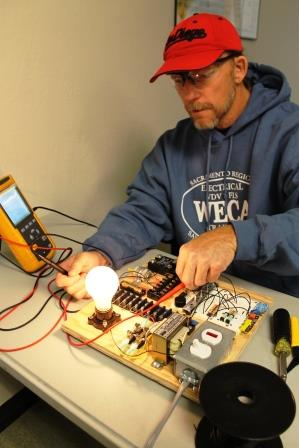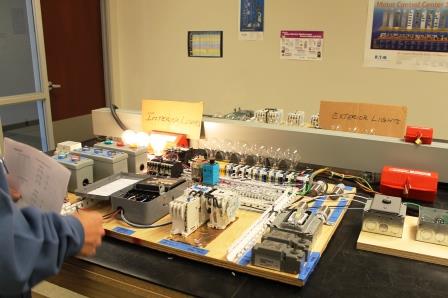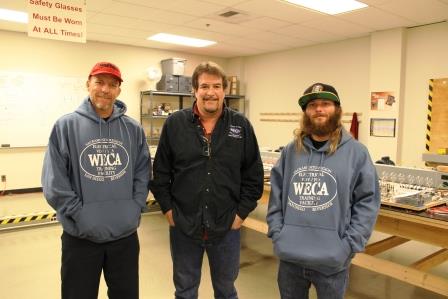WECA Graduating Class of 2014 Ready for Green Tech Demands
|

|
|
Adam Boyte working on control circuit device.
|
Recently, students in the residential apprenticeship program completed a hands-on lab course focused on energy efficiency.
Students worked on interactive lab projects designed to teach the principles of how energy saving devices work and how they are applied to homes and buildings.
For example, students worked on lighting controls that can automatically turn off lights or dim them according to light levels. They also worked on energy creating technologies like photovoltaic (solar) panels and how they are installed and integrated.
As the demand for energy efficient design and installation of green technologies increases, there will also be a demand for electricians with a solid understanding of how these systems work.
Mike Moyer, WECA Nor-Cal Instructor, describes the energy efficiency labs in detail:
Every structure utilizing electrical power whether it's a home, an office building, a store or a large industrial facility, must use electricity efficiently to promote sustainable management of our energy resources.
The most effective way to conserve energy is to simply turn off electrical loads when they are not needed. The intent behind automation is to have other devices turn circuits on and off and eliminate the human element.
Automation is the first step in using electricity efficiently and in our apprenticeship programs we want our apprentices to fully understand the operating principles behind the most common devices used in automation and how these devices are implemented into electrical circuits.
|

|
|
Bryce Sage demonstrates photocell switch on lab board.
|
Relays are some of the most common devices used for automation and electronic devices allow automation to be performed much more efficiently. With that said, this is where the second semester residential curriculum begins. The students learn how current is distributed through electronic circuits using lab exercises.
"These hands-on lab exercises accomplish two things; first, students learn how different electronic components operate and second, they practice interpreting wiring diagrams in order to build functioning electronic circuits that can support energy efficient devices," said Mike Moyer.
Electricians are required to install sensors to meet energy efficiency standards for Residential and Nonresidential Buildings (Title 24). Sensors use electronic components to operate and a little knowledge in this area helps the electrician better understand the various technologies involved with different types of sensors.
|

|
|
Adam Boyte in the electronics lab building a light dimmer switch.
|
The electronic labs are a perfect segue into solar energy. Silicon is the conductive material used to make solid-state devices and is also the conductive material used to make photovoltaic (solar) panels. The theory of how electrons move through this material is easily translated between the two technologies.
The solar portion of WECA's apprenticeship curriculum covers theory and the equipment involved with solar installations. Students use their knowledge of diodes to understand how these electronic components are used in solar panels and in solar voltage regulators. They are also able to use their newly obtained knowledge of transistors to better understand how solar inverters are used to change generated DC power to AC power.
The solar curriculum includes a lab exercise with worksheets so students learn how solar panels are configured to build system voltage levels then combined to increase system power levels. Worksheets are also used to address Code requirements for solar installations and to properly size system circuit conductors so the power generated by the solar panels can efficiently be delivered to the electrical loads to be served.
The electronic labs also allow our residential students to learn about LEDs (light emitting diodes). LEDs are quickly becoming the dominant option for incandescent bulb replacement for their high energy efficiency, small form-factor, and lower operating temperature. Our residential graduates as well as our commercial graduates are seeing more replacement and new construction builds using LED lighting systems. The labs help students to understand how to read and interpret the control circuit wiring diagrams of these new LED systems. It helps them to successfully install and troubleshoot these devices.
There are a total of 10 lighting control lab exercises students build to aid their understanding of solid-state sensors (electronic switches) and electromechanical devices (relays and contactors).
Students work with mechanically-held lighting contactors and electrically-held lighting contactors, two-wire and three-wire type sensors, momentary and maintained type mechanical switches.
|

|
|
A toggle switch controls the interior lighting circuits during daylight hours.
|
In this lab exercise students followed a control circuit wiring diagram to wire three exterior lighting circuits and three interior lighting circuits controlled using two electrically held contactors.
The photocell sensor is a solid-state switch that is used to detect darkness. At night it delivers a signal to the control circuit to automatically control the interior and exterior lighting contactors.
A timeclock is incorporated into the control circuit to improve the efficiency of the automation. This allows the exterior lighting circuits to be turned off during a particular portion of the night time automation to save energy and then turn back on later during the automation period. This application can also be used to control the lighting around a building to ensure exterior lights are turned-off on overcast days in which using a photocell alone might keep the lighting circuits on, and thus waste energy.
Relays can be used to expand the switching capability of the control process. In this example a timing relay is used in the control circuit to override automation and turn on the interior lighting circuits for a specific period of time. This would allow the lights to be turned on if someone entered the building at night and then automatically turn back off if the person leaves the building but forgets to turn off the lights.
|

|
|
Residential Graduating Class of 2014. Left to right, Adam Boyle, Mike Moyer (WECA Instructor), and Bryce Sage.
|
When students complete their apprenticeships, they have a better understanding of "Green" energy saving technologies and the core skills to design, implement and test these technologies in their future careers. Whether the electricity is privately generated by the utility or publicly generated through renewable resource, electricity must be used efficiently. Automation allows electricity to be used more efficiently regardless whether the control systems are mechanical, electromechanical, or solid-state electronics--overall, these devices at their core are simply switches.
If a solid-state device senses motion, sound, heat, light or temperature, it's still a switch. if the equipment is a lighting control panel or a complete energy management system, it's still comprised of switches, relays and contactors. Our labs and curriculum give students a better understanding with the ability to interpret wiring diagrams and not become intimidated by this technology. Students are better prepared for the greening of our industry.
Has green tech gotten you interested in becoming an apprentice too? Learn more about WECA's Apprenticeship Programs and how to apply HERE.